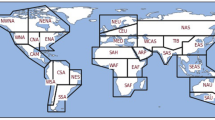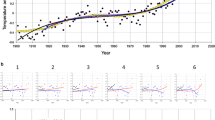Abstract
We analyze results of 15 global climate simulations contributed to the Coupled Model Intercomparison Project (CMIP). Focusing on the western USA, we consider both present climate simulations and predicted responses to increasing atmospheric CO2. The models vary in their ability to predict the present climate. In the western USA, a few models produce a seasonal cycle for spatially averaged temperature and/or precipitation in good agreement with observational data. Other models tend to over-predict precipitation in the winter or exaggerate the amplitude of the seasonal cycle of temperature. The models also differ in their ability to reproduce the spatial patterns of temperature and precipitation in the USA. Considering the monthly mean precipitation responses to doubled atmospheric CO2, averaged over the western USA, we find some models predict increases while others predict decreases. The predicted temperature response, on the other hand, is invariably positive over this region; however, for each month, the range of values given by the different models is large compared to the mean model response. We look for possible relationships between the models’ temperature and precipitation responses to doubled CO2 concentration and their ability to simulate some aspects of the present climate. We find that these relationships are weak, at best. The precipitation response over the western USA in DJF and the precipitation response over the mid- and tropical latitudes seem to be correlated with the RMS error in simulated present-day precipitation, also calculated over the mid- and tropical latitudes. However, considering only the responses of the models with the smallest RMS errors does not provide a different estimate of the precipitation response to a doubled CO2 concentration, because even among the most accurate models, the range of model responses is so large. For temperature, we find that models that have smaller RMS errors in present-climate temperature in the north eastern Pacific region predict a higher temperature response in the western USA than the models with larger errors. A similar relation exists between the temperature response over Europe in DJF and the RMS error calculated over the Northern Atlantic.





















Similar content being viewed by others
References
Climate Prediction Center Merged Analysis of Precipitation (CMAP), http://www.cpc.ncep.noaa.gov/products/global_precip/html/wpage.cmap.html
Coupled Model Intercomparison Project (CMIP), http://www-DOE PCMdi.llnl.gov/cmip/
Covey C, AchutaRao KM, Cubasch U, Jones P, Lambert SJ, Mann ME, Phillips TJ, Taylor KE (2003) An overview of results from the Coupled Model Intercomparison Project. Global Planet Change 37: 103–133
Duffy P B, Govindasamy B, Iorio J, Milovich J, Taylor K, Wehner M, and Thompson S (2003) High resolution simulations of global climate, part 1: present climate. Clim Dyn 21: 371–390
European Center for Medium-Range Weather Forecast ERA15 Reanalysis, http://www.ecmwf.int/research/era/ERA-15/
Giorgi F, Brodeur SC, Bates GT (1994) Regional climate change scenarios over the United States produced with a nested regional climate model. J Clim 7: 375–399
Kim J, Kim TK, Arritt RW, Miller NL (2002) Impacts of increased atmospheric CO2 on the hydroclimate of the western United States. J Clim 15: 1926–1942
Kittel TGF, Giorgi F, Meehl GA (1998) Intercomparison of regional biaises and doubled CO2-sensitivity of coupled atmosphere-ocean general circulation model experiments. Clim Dyn 14: 1–15
Leung LR, Ghan SJ (1999) Pacific Northwest climate sensitivity simulated by a regional climate model driven by a GCM. Part II: 2 ×CO2 simulations. J Clim 12: 2031–2053
NCEP/DOE AMIP-II Reanalysis, http://wesley.wwb.noaa.gov/reanalysis2/index.html
Pan Z, Christensen JH, Arritt Rw, Gutowski Jr WJ, Taule ES, Otenio F (2001) Evaluvation of uncertianity in regional climate change simulations. J Geophys Res 106: 17,735–17,752
Snyder MA, Bell, JL, Sloan LC, Duffy PB, Govindasamy B (2002) Climate responses to a doubling of atmospheric carbon dioxide for a climatically vulnerable region. Geophys Res Lett 29: 1–4
Acknowledgements
This work was performed under the auspices of the USA Department of Energy by the Lawrence Livermore National Laboratory under contract No. W-7405-Eng-48. We thank Drs. C. Covey and B.D. Santer for their interest in this work and helpful suggestions. We also thank C. Doutriaux for his technical contributions to several aspects of the analysis.
Author information
Authors and Affiliations
Corresponding author
Rights and permissions
About this article
Cite this article
Coquard, J., Duffy, P.B., Taylor, K.E. et al. Present and future surface climate in the western USA as simulated by 15 global climate models. Climate Dynamics 23, 455–472 (2004). https://doi.org/10.1007/s00382-004-0437-6
Received:
Accepted:
Published:
Issue Date:
DOI: https://doi.org/10.1007/s00382-004-0437-6




